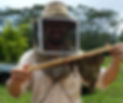

Sustainable Beekeeping Practices
for
Healthy Honeybees
We are
Pollinator Protectors
on a mission to create balance and harmony for all.
In every flower, a vow we sow—to help the pollinators grow.

At Paradise Nectar Apiaries, we are passionate about sustainable beekeeping practices.
Founded in 2008 by Jen Rasmussen Lair in Hawaii, we take pride in offering treatment-free honeybees, natural-cell queens, and education to promote pollinator health.
Join us in supporting honeybees and ensuring harmony in nature.
Paradise Nectar Apiaries
The buzz about us..
At Paradise Nectar Apiaries we believe quality and integrity are the most important ingredients in everything we create. As parents with two children we see the importance of showing them how to care for the Earth and all life so that we may continue to enjoy this planet. We spend our days in the gardens, tending to our bees, tropical fish, & animals, and processing all the food and products we harvest. It is a full and beautiful life and we love it. Our bees are a big part of it. They have made all that we have possible and continue to provide us with pollination for our fruit trees and vegetables, delicious hive products, and thanks to years of commitment and paying it forward, they continue to bring in financial support to keep this whole farming business as sustainable as possible. We set high standards and live up to them. That is our promise to you, pure products from the hive, and much more.

The Paradise Nectar Team

Jen Rasmussen Lair
Bee Guardian, Owner & Creator of Paradise Nectar
Owner & Chef of Island Organic Cuisine

John Lair
Carpenter, Husband, Owner of Hawaii Tropical Fish Gardens & Co-Owner of Island Organic Cuisine.
Island Organic Cuisine

Paradise Nectar & Island Organic Cuisine are the creations of Jen Lair.
Jen is passionate about organic gardening and preparing meals with locally grown organic ingredients.
Since becoming a mama over twenty years ago, eating an organic diet and providing home cooked healthy meals has become her passion. She crafts organic meals, drinks, sauces, body care products and more with love and integrity.
Health & wellness is at the heart of every creation.

Island Organic Cuisine started as a way to reach the community about the importance of honeybees and supporting organic farmers since Paradise Nectar Apiaries had been impacted from the neighbors and county workers spraying. For over six years our bees were evidence of how harmful and toxic herbicide, like glyphosate is.
The mission became clear. To be part of the change we want to see we started buying organic products from local organic farmers and selling food we were growing like cassava and honey. Island Organic Cuisine started with a food trailer that was parked in Keaukaha for over a year and shared the love & passion for food that is always organic & delicious and information about pollinator protection.
After relocating Paradise Nectar Apiaries at the end of December 2024 to Mountain View, Hawaii, it became clear that the vision & future of Island Organic Cuisine was changing.
Island Organic Cuisine will now be offering catering & private chef services, cooking classes, farm-to-table meals, workshops & retreats, and delicious honey-based sauces & dressings made with honey from Paradise Nectar Apiaries.
Island Organic Cuisine & Paradise Nectar are excited about the upcoming new offers, which are still being kept a surprise until the grand opening. Jen & John Lair are delighted to create a dining experience like no other.
.png)

Lilikoi Lava Hot Sauce
Made with locally grown organic lilikoi puree from Wilmin, LLC and pure honey from Paradise Nectar Apiaries.

Our food trailer experience revealed how much people love our honey-based sauces & dressings! Try our delicious Garlic Honey, Lilikoi Lava Hot Sauce, Turmeric VInaigrette & more!!
Experience
Intuitive & Hygienic Beekeeping
Learn with Jen Rasmussen Lair
Discover the world of beekeeping at Paradise Nectar Apiaries.
Join us for hands-on experience with live bees and learn about intuitive treatment-free practices for honeybee health.
Capture unforgettable moments with our friendly bees!
Book your session on weekends from 1-3 pm.

TESTIMONIALS
"Awesome and fun learning experience. Jen was great - personable and knowledgeable. She let us in on her farm life, explained in depth about bee life and answered allllll of our questions. It was a fun time, rain didn’t bother us at all as there is a covered area for the entire experience."
Yotam, April 2023
"This was our second time visiting Jen’s place to meet the bees; this time we brought our kids (ages 7-10). Everyone really enjoyed suiting up and heading down to the “bee yard” to get up close and personal with several hives. It’s obvious that Jen is passionate about what she does, and her connection with the bees is amazing. A small tour of the farm and some delicious honey samples were a great way to finish things up!"
Julian, March 2023
"I learned more about beekeeping from Jen in one day than all of the videos I had been watching combined!! Not only is this apiary in a gorgeous location for a farm tour but the honey produced here is so delicious, and her merch is super cute too! Jenʻs knowledge and expertise makes her a delight to learn from. If I could give this place and my experience 10 stars I would!"
Candice D, May 2023
"Jen was very friendly and warm. We have a great time walking around their farm. Jen is very passionate about beekeeping, its unlikely that you could possibly finds anyone else who know the bees better than her. She teaches apiculture in the university. Besides the bees, their dog, goats and cows are very welcoming! 👏🏽"
Nirpeksh, January 2023
"Great experience! Be ready to learn about the different bees, their roles in the hive, what keeps them healthy, what threatens them, and how to deal with stings should one occur. Wear the gear if you’re apprehensive at all, and be sure to chow down on the delicious honeycomb provided at the end. You won’t be disappointed!"
Arturo, December 2022
"This was such a wonderful and eye opening experience. Jen was so welcoming and did a very thorough job in explaining her part in helping the honey bees. We walked through her farm where we saw so many beautiful flowers, fruit trees, and animals! We got hands on with the bees and I learned so much about the role of bees and our impact to them. This was a great introduction to the world of bees and I certainly recommend for anyone interested in learning more about bees."
Mary, August 2022

Frequently Asked Questions



.png)








































































